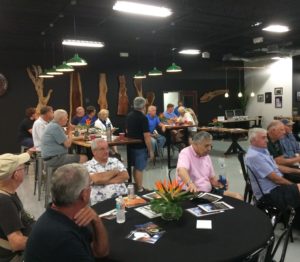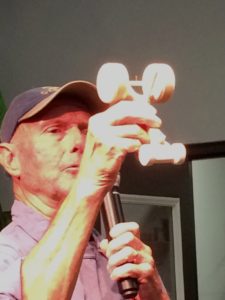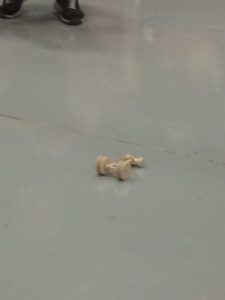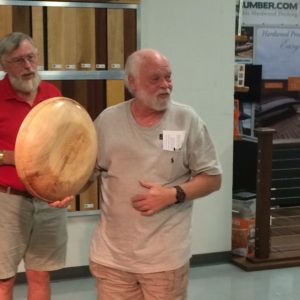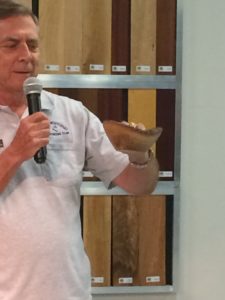At 7:00 PM club President Joe Mannke opened the meeting at Advantage 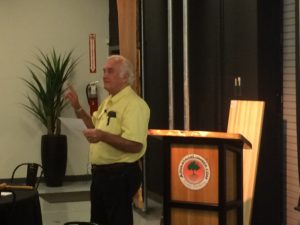 Lumber. Joe announced services for Tony D’Alberto will be held at 9:30 on August 18, 2018 at Saint Thomas More Catholic Church. Tony will be missed by all of us. In another sad note, Joe said that John Philips is in Sarasota Memorial Hospital in ICU and not yet ready for visitors or phone calls. Get well soon, John.
Lumber. Joe announced services for Tony D’Alberto will be held at 9:30 on August 18, 2018 at Saint Thomas More Catholic Church. Tony will be missed by all of us. In another sad note, Joe said that John Philips is in Sarasota Memorial Hospital in ICU and not yet ready for visitors or phone calls. Get well soon, John.
Featured Presentation
This evening’s presenter is Ralph Bagnall  demonstrating stringing and simple bell flower inlays. Ralph makes an Amazon Prime TV show called Woodcademy with the woodcademy.com web presence. If you have Amazon Prime, then Ralph’s TV show is free to view, check it out. One may also recognize his work from Woodcraft magazine or Woodworkers Journal magazine or for the YouTube videos under his name..
demonstrating stringing and simple bell flower inlays. Ralph makes an Amazon Prime TV show called Woodcademy with the woodcademy.com web presence. If you have Amazon Prime, then Ralph’s TV show is free to view, check it out. One may also recognize his work from Woodcraft magazine or Woodworkers Journal magazine or for the YouTube videos under his name..
Club members on our internal email list received a file explaining Ralph’s method to make simple bell flower inlays using three sizes of gouges. Ralph says pick the sizes that you find most pleasing to the eye, and in a few minutes, he made an inlay with the technique described. Wood species suggested are those of contrasting color, with the perennial favorite of Holly used in its veneer form. 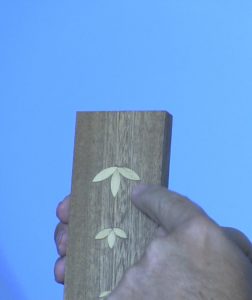 Holly has become so much of a favorite that it is now expensive, so don’t expect to find large pieces, and he says Constantine’s sometimes has it. Once purchased it lasts for a long time. Should a dark color such as black be desired, he suggests buying poplar veneer and dying it black, or presumably even another color. Alternately, differing wood species can be used to increase color selection.
Holly has become so much of a favorite that it is now expensive, so don’t expect to find large pieces, and he says Constantine’s sometimes has it. Once purchased it lasts for a long time. Should a dark color such as black be desired, he suggests buying poplar veneer and dying it black, or presumably even another color. Alternately, differing wood species can be used to increase color selection.
Subtle blending can be done by placing the pre-cut holly inlays in hot sand for a while. The portion covered by sand will char a tannish brown color and any unheated portion will remain white, in the dame manner as pyrography.
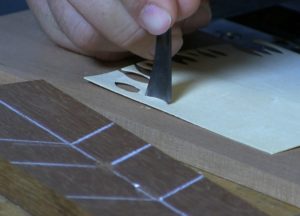 His inlays are done by hand because sometimes hand tools are faster and he advises to take one’s time. Match the corners of the gouges to space both the inlay and the recess. He says, three stokes and you’re done. Bell flower petals can be placed partially on top of previous glued in petals to emphasize a three dimensional
His inlays are done by hand because sometimes hand tools are faster and he advises to take one’s time. Match the corners of the gouges to space both the inlay and the recess. He says, three stokes and you’re done. Bell flower petals can be placed partially on top of previous glued in petals to emphasize a three dimensional 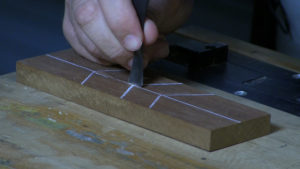 look. Those gouges can also be used with a pencil to layout a potential design on paper first to get a feel for how the finished item will look.
look. Those gouges can also be used with a pencil to layout a potential design on paper first to get a feel for how the finished item will look.
Stringing was also demonstrated as being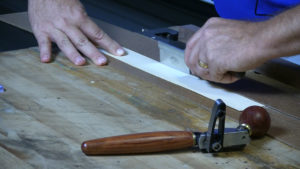 similar to pin striping as it is decorative in nature. Much like the dovetail question, does one do pins or tails first, stringing debates cutting the groove first or the string first. Ralph answers this by showing his shop built stringing jig consisting of two pieces of flat Masonite glued one on top of the other. The secret, is the top piece has a 1/32 inch grooved lip in it to house an inserted piece of veneer. Ralph then takes a
similar to pin striping as it is decorative in nature. Much like the dovetail question, does one do pins or tails first, stringing debates cutting the groove first or the string first. Ralph answers this by showing his shop built stringing jig consisting of two pieces of flat Masonite glued one on top of the other. The secret, is the top piece has a 1/32 inch grooved lip in it to house an inserted piece of veneer. Ralph then takes a sharp veneer saw and ripsaws the veneer using the remaining face of the top Masonite as a straight guide. Using a knife may result in the sharp edge following the grain of the Holly, rather than the straight edge of his jig.
sharp veneer saw and ripsaws the veneer using the remaining face of the top Masonite as a straight guide. Using a knife may result in the sharp edge following the grain of the Holly, rather than the straight edge of his jig.
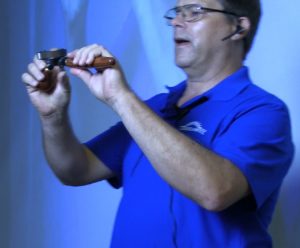 Since the stringing produced is uniform he standardizes on a single cutter in his stratchstock and it does not matter which one he cuts first. Sometimes he will make his own scratchstock cutter from a spent utility knife blade by snapping off the triangular portion square and then grinding the desired shape to fit his tool.
Since the stringing produced is uniform he standardizes on a single cutter in his stratchstock and it does not matter which one he cuts first. Sometimes he will make his own scratchstock cutter from a spent utility knife blade by snapping off the triangular portion square and then grinding the desired shape to fit his tool.
Cutting the groove cross grain does bring out a sharp knife or a chisel since a scratch stock tends to have problems there. Even a marking gauge could be used, or a compass with a sharp blade replacing the pencil if curved work is to be done. Stringing can be soaked to make following sharp curves easier. He tends to make all the grooves shallow, so that his stringing sits slightly proud of the work piece. Then, he places a small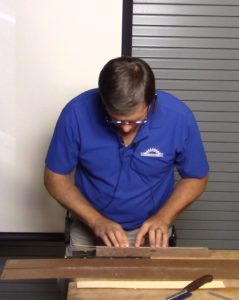 amount of glue in the groove to hold the stringing, and glue squeeze out is removed with a cabinet scraper which trims the stringing flush.
amount of glue in the groove to hold the stringing, and glue squeeze out is removed with a cabinet scraper which trims the stringing flush.
Should the groove be cut a fraction deeper than required in a few spots, Ralph avoids problems by using a flat board to put pressure on the stringing during glue up. As the board spans between the stringing and the workpiece, there is no pressure to push the stringing veneer any deeper than flush with the surface.
Care should be taken when choosing stock intended for stringing, as one side of a piece of stock can be straight grained while if one turns the piece 90 degrees, wavy grain can prevail making straight grooves all the more difficult to cut. He also rough mills his stock a day or so early and lets it sit so that any reaction wood can do its damage and be corrected in final milling.

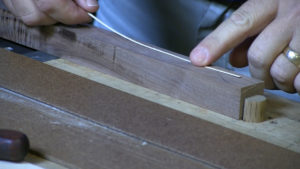 Ralph does not mitre corners on stringing, calling that effort unneeded. A poor mitre joint is much more noticeable that a simple butt joint. He uses a modified screwdriver ground to a sharp edge to finish cleaning out intersections of stringing grooves. He uses the screwdriver just like a small chisel.
Ralph does not mitre corners on stringing, calling that effort unneeded. A poor mitre joint is much more noticeable that a simple butt joint. He uses a modified screwdriver ground to a sharp edge to finish cleaning out intersections of stringing grooves. He uses the screwdriver just like a small chisel.
Since expensive Holly is selected because it does not yellow over time, Ralph favors Minwax Polycrylic as a finish. He notes it does not stink up his shop and does not yellow in his experience.
 Before concluding, Ralph demonstrated the new Bessey gear clamp that excels in tight spaces with a reported 600 pounds of clamping force. Turning the lower handle actuates an internal gear that moves the upper clamp pad in and out. No doubt this will soon be available thru Amazon Prime. Just a cautionary note here, Amazon Prime can result in a lack of space to store one’s tools.
Before concluding, Ralph demonstrated the new Bessey gear clamp that excels in tight spaces with a reported 600 pounds of clamping force. Turning the lower handle actuates an internal gear that moves the upper clamp pad in and out. No doubt this will soon be available thru Amazon Prime. Just a cautionary note here, Amazon Prime can result in a lack of space to store one’s tools.
Business Meeting
Treasurer Randy Cooper provided a summary report, and members were reminded of proposed changes to the holiday menu, including Cornish hens and homemade lasagne to go along with our traditional ham and turkey. Eventually, members will be asked if they desire to reserve one-half of a Cornish hen in order to help with the party planning. The ham, turkey, and lasagne are all items allowing smaller portions to be taken to round out a dinner plate, but cutting a Cornish hen into smaller pieces could prove troublesome. Does everyone want a sample of each, including one-half of a Cornish hem, as that can be done too? Remember one can always resume a diet then next day.
Denny Wetter reported that the bowls for hunger campaign is continuing with a goal of fifty bowls. He says so far he has not gotten many back, but there is still plenty of time.
A previous winner of a partial scholarship to Tampa School of Woodworking reported he is unable to use the credit, and it was put up for chance distribution with Tom Tengen winning the coin toss. Congratulations and come back and tell us about your experience there Tom.
Show and Tell
The night’s show and tell had three participants.
Terry Bair remarked that he did not 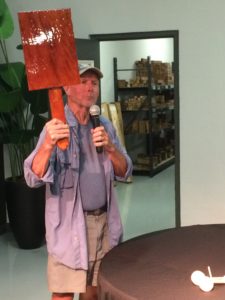 care for epoxy as a wood finish, but an outdoor sign he made and coated with epoxy is expected to last for many more years. He also demonstrated a rubber band powered race car made from a set of published plans. Terry said he does not have a lathe so he resorted to a hole saw to make the wheels and then finished sanded them round.
care for epoxy as a wood finish, but an outdoor sign he made and coated with epoxy is expected to last for many more years. He also demonstrated a rubber band powered race car made from a set of published plans. Terry said he does not have a lathe so he resorted to a hole saw to make the wheels and then finished sanded them round.
Tom Falcone showed a different side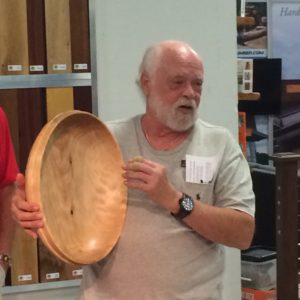 of Norfolk Island Pine, which he abbreviates NIP by turning a large bowl from the side of the tree rather than the usual end grain turning one sees in this species. The bowl had none of the characteristic red knots, but was streaked with blue stains and featured beads on the rim. He likes beeswax and mineral oil for a finish.
of Norfolk Island Pine, which he abbreviates NIP by turning a large bowl from the side of the tree rather than the usual end grain turning one sees in this species. The bowl had none of the characteristic red knots, but was streaked with blue stains and featured beads on the rim. He likes beeswax and mineral oil for a finish.
John Darovec showed his rescue bowl 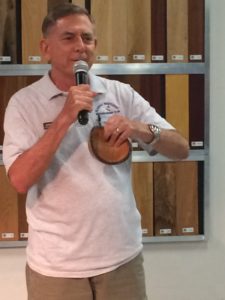 made from an errant piece of laurel oak cut from a branch. He says Susan started this bowl two years ago and he wanted to finish it. Remarkably, he was able to maintain the natural edge and he finished with poly.
made from an errant piece of laurel oak cut from a branch. He says Susan started this bowl two years ago and he wanted to finish it. Remarkably, he was able to maintain the natural edge and he finished with poly.
Tonight’s probability study had Barry Meyers walking away with the raffle prize.
Text by Andrew DiLorenzo, recording secretary.

